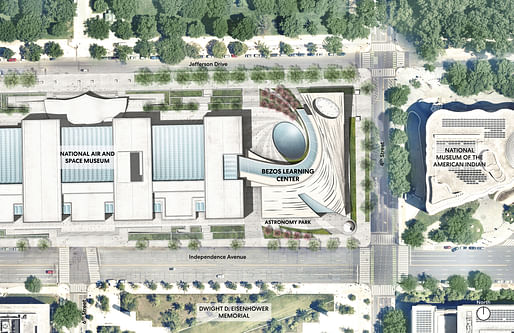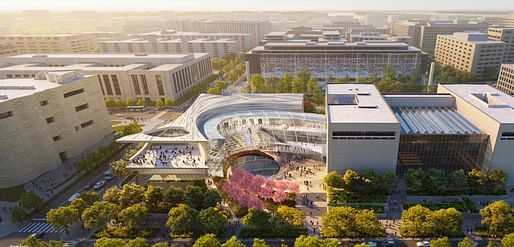

Perkins&Will has just been announced as the lead designers of the new Bezos Learning Center at the Smithsonian Institution’s National Air and Space Museum in Washington, D.C.
The firm’s winning design was selected over a shortlist that included five anonymous proposals submitted by leading global architectural firms.
The center is supposed to be enacted in the space once occupied by Gyo Obata’s now-demolished glass pyramid structure from 1988. Once completed, the new addition will entail approximately 50,000 square feet of exhibition spaces, a rooftop terrace, a public observatory, and dining options. Its spiraling form is meant to evoke the shape of the galaxy. Total costs for the project are expected to be around $130 million.
“The spiral galaxy — our source of creative inspiration — is all about infinite possibilities,” the project's lead designer, Ralph Johnson, says of its conceptual approach and vision. “We are grateful for the opportunity to work with the Smithsonian Institution, the National Air and Space Museum, and other key stakeholders to create a design that will inspire the next generation of air and space explorers while honoring the historical context of our National Mall.”

So-called “non-traditional” classroom spaces, collaboration hubs, and a studio are also provided in support of the project’s educational mission to further STEAM education for K-12 learners whose work on various design challenges will later be displayed in dedicated areas.
A further design challenge geared specifically at architecture students will also offer the chance to create an unnamed architectural element for the building’s exterior. The challenge is now in Phase 2. Once selected, the winner will be invited to join Perkins&Will’s project team in addition to receiving a paid position with the National Air and Space Museum for up to three years.
Speaking of the Smithsonian Institution, Perkins&Will's chair of cultural and civic practice and one of the lead principals on the project, Zena Howard, said they are “inspired by clients who are intentional about outreach to underserved communities.” The project is being funded partially by a $200 million donation from the Amazon founder.
The firm expects construction to be complete by the end of 2027.
No Comments
Block this user
Are you sure you want to block this user and hide all related comments throughout the site?
Archinect
This is your first comment on Archinect. Your comment will be visible once approved.